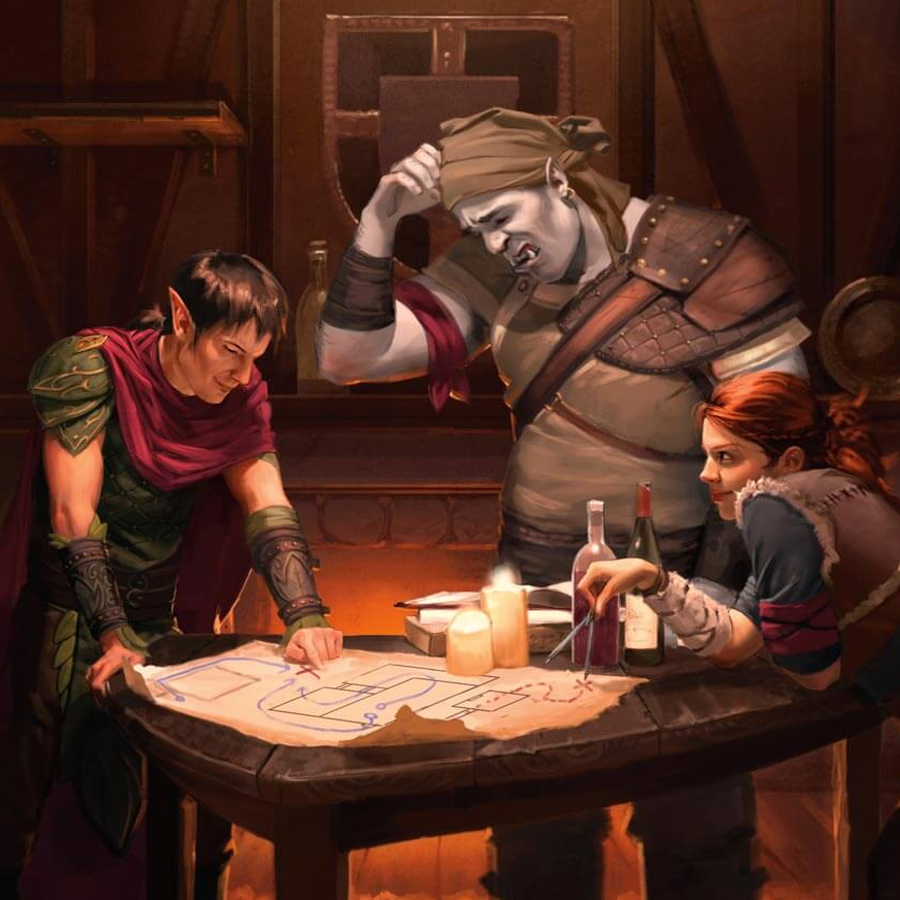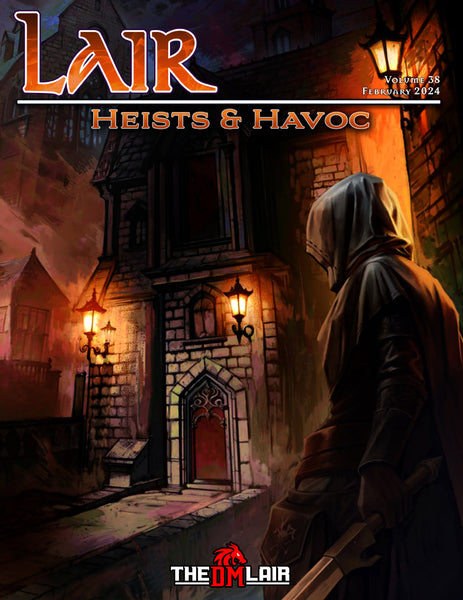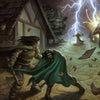How To Run a Heist in D&D

By Luke Hart
Despite the title on the cover of Waterdeep: Dragon Heist, it is not a heist—just in case anybody was confused about that. It’s not a bad adventure module; it’s just not a heist. So, what is a heist, and how do you run one for your D&D game? This article will answer those questions and touch on how a raid is closely related to a heist.
Before we get to that, running awesome games with in-depth lore, deadly traps, and terrifying monsters doesn’t have to take hours of prep! Lairs & Legends 2 and Loot & Lore 2 have everything you need to cut your prep time in half while preserving your campaign and your story! These two massive tomes are designed to let you plug-and-play encounters, monsters, magic items, brain-burning puzzles, and more easily into your game!
Or you’ve just needed that one really cool thing for your game, but it’s just not coming to you?
Both books contain hundreds of pages of 5e game master resources, carefully crafted by a team of expert game masters to be both exciting to run and easy to use. You don’t need to parse through dense paragraphs trying to find something useful; just take a quick glance through it and you’ll have everything you need at your fingertips.
Watch or listen to this article by clicking the video below.
1. What is a heist?
Okay, so how is a heist different from a standard location-based adventure, your typical dungeon delve? Well, first, what defines a normal adventure? Usually, the adventuring party needs to visit a location—a castle, an inn, a sewer, a “dungeon”—to accomplish some objective. Usually, this means breaking in, slaughtering the inhabitants, defeating a boss, and collecting loot. Not always, of course, but pick up any adventure module, and that’s usually the gist of things. And there’s nothing wrong with that; I love that play style. However, a heist is different.
The first distinguishing factor of a heist is the challenge it presents. If the party decides to just go for it and try to brute force their way through the adventure, they will almost assuredly fail. Why? Because the defenses and enemy forces in a heist adventure are designed to be too powerful for the characters to handle through force alone. And if they attempt to do so, it should result in defeat. This is something intentional that you’re doing as a game master when you define the heist; you are literally setting up the defenses and forces such that a party’s standard “kick down the door and come out swinging” tactics will not work. Instead, a heist adventure should require a group to use special tactics: stealth, skills, and selective combat.
Now, here’s the thing. Many players are not used to thinking this way. So, the first time or two that you introduce a heist adventure to your group, it would be wise to at least subtly inform them that brute force won’t work. The easiest way to do this is to have a convenient NPC quest giver say something like, “And remember, the defenses and enemy forces of the bandit fortress are nearly insurmountable. The last two groups failed utterly. I advise a more cautious approach. Remember, you only need to retrieve the sacred chalice from the bank’s inner vault.”
Of course, some players might not pick up on the subtlety, which you’ll probably notice as they begin to form a plan (or lack thereof). At that point, it may be worth speaking to them out of character and explaining that the adventure is designed as a heist, what that means, and that their approach should probably be a bit different to achieve success. We’ll get into those specifics soon, of course. Yes, that does ruin the fun of the unknown just a bit, and some players may feel like they are being nudged too strongly toward a method of approaching the adventure. However, the alternative could be a swift defeat or a TPK, so just bluntly telling them what’s up is certainly worth considering.
Okay, now that we’ve established that brute force won’t work, what are we left with? Well, there are a few steps to accomplishing a heist.
Step one of a heist adventure is casing the joint. The characters need to find out what they are up against before heading in. This could involve gathering a building layout plan from the local town administration—either through legal (or less legal) means—or scouting it with a familiar or magic. They’ll want to see if they can determine what defenses might be in place: traps and the like. And if there are guards, where are they, and how powerful might they be? Is there a guard patrol? If so, what’s the patrol pattern so they can anticipate and avoid it? They might enter the location under a legitimate guise, such as going into the bank to open an account so they can observe first-hand what they are up against.
Frankly, how your players case the joint and gather information is up to them. As a GM, you’ll probably be improvising a bit of this on the spot. However, as long as you already have the location planned out, this shouldn’t be too bad.
Step two of a heist adventure is planning. This is where your players take all the information they’ve gathered and devise a plan. Now, this will involve a good chunk of game time, but it’s critical that you give them space to do their planning. It’s an integral part of a heist adventure. The strength of their plan may determine their success or failure. As they plan things out, make sure you are listening and considering what the bad guys might do in response to their plan as they execute it. This is not you trying to undermine their plan; no, you’re just planning how to roleplay the enemy forces in advance so gameplay can go more smoothly once they start executing their plan. In fact, whenever my players are planning something, whether it’s for a heist or not, I’m doing this.
Now, there may be a time when the planning session begins to drag on too long. You can usually tell when this is happening because, one, the players cease to come up with new ideas, and two, they are just waffling back and forth, unable to make up their minds—it’s probably time to step in as a game master and gently nudge them to make a decision. You might even call for a vote or something if needed. I don’t really like having to do this, but sometimes this discussion spiral of death needs to be stopped by the GM, or you’ll just sit there for perhaps hours with no decision. And too much time discussing is usually not super fun.
Step three of a heist adventure is the execution. This is where your players enact their plan, and you run the defenses and enemy forces in the location, the bank in our example. Now, there may be a few twists—the guard isn’t where they thought he would be; they discover a locking mechanism they didn’t know about, and the like—but really, you’re just running a standard adventure at this point. Enemies react like they normally would when they discover intruders; traps go off; there are puzzles—all that sort of thing. However, I’d like to add that my team and I designed some special house rules that make this execution phase much more satisfying, and we’ll get to those in a moment.
2. How to prepare a heist adventure
Okay, great, you know what heist is now, but how do you prepare and design a heist adventure for your players?
First, you need to decide: What is the objective? In our example, the group needs to steal the sacred chalice from the bank’s inner vault. That’s it. No one cares about the guards, the traps, etc. Just get the chalice. Of course, we could increase the challenge a few different ways: get the chalice without killing any guards—they’re just doing their jobs, after all, and have families to go home to—or get the chalice before the rival adventuring party does; or get the chalice without setting off the central alarm. The parameters you set here will impact both the nature and flavor of the heist and the plan your characters come up with.
Next, you need to conceptualize the heist. By this, I mean you need to come up with around three different ways the characters might accomplish their objective. This doesn’t mean the characters must follow any of these three options—they could come up with a different plan that works, of course—but deciding three ways that could work is critical. This guarantees that when you design the heist location, you build those methods into the adventure so there are at least a few possible solutions . . . even if the players ultimately decide to do something else.
Let’s go back to our bank example. One method could be to bribe a worker to let you into the safe deposit area during regular business hours, close the door to give you privacy, and from there, follow the duct system to get into the foyer outside the inner vault. Then, you have a short time to breach the vault, grab the chalice, and get back to the safe deposit room.
Another method could be the tried and true break-in-at-night approach. Pick the lock on the back door; disable the two clockwork guards inside the door; navigate through the hallways while overcoming defenses, alarms, and avoiding the guard patrol; and finally, break the inner vault, grab the chalice, and get out of Dodge without being caught. As long as you know about three different ways that could work, you’ll be able to design a heist adventure that can be overcome by your players’ characters one way or another. That’s the important part.
Finally, you need to flesh the adventure out. Now that you’ve devised a few potential solutions, it’s your job to create the obstacles the characters will find along the way. These are the locked doors, traps, puzzles, guards, etc., they must overcome.
Another thing you’ll want to be sure to do is place clues or “helper” objects or information in the location. For instance, the inner vault in our bank has a key code to open the door. Yes, the characters might decide to blow the door with a cluster of magical charges, but if they search the bank manager’s desk and solve a puzzle on a drawer, they could find the key code. Depending on how their casing phase went, the characters may even discover that the manager keeps the key code in their desk, or there might be a central control room that powers the clockwork constructs at two access points. If the group can get into the control room and disable the control panel, the clockwork constructs cease to function.
That’s what I mean by “helper” objects or information. Basically, you’re building ways for the characters to overcome the heist’s defenses in the adventure. Remember, your goal as the game master is both to place obstacles and potential solutions to them. Again, it doesn’t mean your players will discover and/or even use those solutions, but build them into the adventure nonetheless.
Here are some quick pro tips as you flesh the scenario out:
First, make sure the location is surveyable. One way or another, the characters need to be able to discover a general interior layout and what sort of defenses are in place. Otherwise, it won’t be a heist; it will be a raid—more on that later—and the casing and planning phases will be mostly pointless.
Second, have multiple entrances. For the bank, this could be the front door used by customers, the rear employee entrance, a couple windows, and the skylight above the central atrium. Remember, windows are entrances. Furthermore, if not obscured by blinds or shutters, windows can be survey points where characters can learn about the bank’s interior. Multiple entrances give players options; it helps avoid making your heist feel like a railroad.
Third, include multiple objectives. This makes things more interesting and challenging. Don’t just retrieve the sacred chalice, but make sure you don’t set off the central alarm, and for heaven’s sake, don’t kill any guards!
Next, include a timing component. This is the ticking clock that keeps the party moving. Whenever an exterior entrance is opened after bank hours, if the key code isn’t entered into the control panel within 15 minutes, the central alarm goes off. So hurry!
Finally, include secrets. These are things that characters cannot discover during the casing phase and only find out during the execution phase. These secrets might be unknown defenses, clues, or helpful objects. Either way, you want there to be more for the players to discover as they play the scenario.
3. How to run a heist adventure
Okay, now that the adventure is planned out, you just need to run it. And, for the most part, at this point, running your heist adventure is much like running any other adventure. Obviously you give your players their casing and planning phases, but at that point you’re basically just adjudicating the scenario as they play through it. You’re the arbiter, the referee, just like you would normally be. However, there are two important things to keep in mind for heist adventures.
First, don’t get married to your intended plans. Yes, you spend time developing and designing three different ways your players might overcome the obstacles in the bank, but as I said, your players might try something different. If they do, that’s okay. Roll with it.
Now, there are two approaches you could take if your players do this.
One, you can decide that their approach is, in fact, a possible solution, and on the fly, create things in the bank that would facilitate the approach they’ve decided to take. It will still be challenging, and you’ll still have obstacles in place, but you’re creating the possibility of success instead of just having them run into a wall with their approach.
Alternatively, you can just play the scenario as-is. The defenses and guards in the bank are what they are, and you play it as it lies. You make no changes on the fly. Your players’ approach may or may not work, depending on how the scenario plays out. It’s quite possible that what they are trying to do cannot work, and they’ll need to adjust their approach on the fly once they are in the bank.
I don’t think there is a correct approach here; I routinely do both in my games. However, I will tell you that I prefer to not change the scenario; instead, the players might need to change their approach if their first one fails. In my opinion, this makes the game more interesting, fun, and challenging; it also increases the verisimilitude—the realism of the heist. I mean, do heists ever go perfectly? Isn’t there always a wrench thrown in there? Isn’t there always an escalation point where the stakes are raised? Shouldn’t there be a setback to make it more dramatic?
Second, be prepared to move stuff around. Yes, I know I just gave you a lecture on the value of not changing things on the fly, but my point here is a bit different. You see, your players might have a viable approach, and they could be making great progress, and they may know that the bank manager keeps the key code in his office. However, what if while they are in the office, they just don’t find the secret drawer where it is kept? What if they didn’t think to look in that spot, or their dice rolls just sucked it up? Should you allow the group to fail right there? Would that be satisfying? Now, for some groups, yes, it would. For some groups, they’d just improvise and try something else.
However, in some cases, you might consider just placing that secret compartment over on the bookcase where the group did decide to look. By doing this, things don’t come to a standstill or bog down. They still need to solve the puzzle to open the compartment, but at least they can continue moving forward in the scenario. I can’t tell you when you should or shouldn’t do this sort of thing. You’ll have to decide based on your gut and what you know about your players, their preferences, and their play style.
4. Special heist house rules
Alright, baby, now for our heist house rules, and I got four of these for you.
First house rule: Get rid of perception. Now, this applies during the casing phase and the execution phase when characters are in the location, the bank, and playing through the scenario. And why, you might ask? Because if you use perception or investigation checks for all the things they are typically used for, what tends to happen is that one player, the one with the best perception modifier, is making all these rolls while everyone else just watches or discreetly—discreetly, mind you—sees what’s happening on their phones.
Now, you don’t want to entirely get rid of perception and investigation; I was exaggerating to make a point. However, you want to use other skills that might apply as much as possible. For instance, if the characters are trying to determine if a hallway is a viable egress route, that could be a Stealth check, or even Acrobatics or Athletics. You see, those might be the skills they would actually use when attempting to use the hallway to get away, so those are the skills they use to determine if it’s possible. If the characters discover a trap on the inner vault door and want to figure out how to bypass it, instead of investigation, you might call for a Sleight of Hand, Thieves’ Tools, or even an Athletics check.
In essence, what you’re trying to do here is encourage all players to be able to participate in these stages of the game, and you do this by allowing skill checks that ordinarily wouldn’t apply. Otherwise, like I said, you have one or two players playing the game while everyone else just watches.
Second house rule: Get rid of stealth. In a heist, remaining stealthy is going to be very important, and yet everyone who has ever played D&D or Pathfinder or whatever knows how this works. It only takes one character to screw things up when they fail a Stealth check, and that stupid paladin is 100% guaranteed to screw things up. Even if you use group Stealth checks, things could get dicey fast. And because there will probably be lots of stealth checks in a heist, adjusting this game mechanic becomes even more necessary.
So, we’re going to take a similar approach to stealth as we did perception: If a player can justify using a different skill to be stealthy, they may. For instance, if they want to move across the ceiling beams to sneak by a guard patrol or hide from one, you could call for an Athletics or Acrobatics check. If the player with an automaton character wants to impersonate one of those clockwork guards, you could ask for a Performance check. And, of course, you can just ask your players what skill they might want to use, although they must justify why it would apply.
Just be careful here because I’ve heard some flimsy justifications over the years. Maybe in some situations, a wizard might be able to use Arcana to be stealthy, but most of the time, that’s going to be a hard no—UNLESS they first cast invisibility or something like that. So, be prepared and willing to say no is all I’m saying.
Third house rule: Use heist initiative. This means that while you’re in the execution phase, actually running the heist, everyone rolls initiative, and you play characters’ actions out in initiative order. This may seem counterintuitive like it will bog the game down, but if done correctly, it can help keep things moving and also keep all your players engaged. However, there are some distinctions between heist initiative and ordinary combat initiative.
First, all characters roll initiative when they arrive at the adventure location, and you keep this initiative throughout the adventure.
Second, on each character’s turn, they are prompted for what they would like to do, but they are not limited to standard “actions” that might happen in combat. For instance, they could try to cross a room unseen, have a brief conversation with a guard as a distraction, or create a diversion to lure guards away from their initial location.
And this leads us to the third difference: These rounds are not limited to just 6 seconds as they would be during combat. Things that take longer should be allowed, within reason, of course. You do want to keep things moving around the table, which means players taking their turns. So, if the wizard wants to spend 10 minutes casting dispel magic, that’s great, but in the meantime, the other characters could go through a few rounds of stuff as well.
Using heist initiative should streamline the gameplay because, in theory, your players have already determined how to overcome the obstacles during their planning phase. And frankly, forcing initiative on the players during the execution should hopefully prevent them from falling back into a 30-minute planning conversation in the middle of the heist. Instead, they can only discuss things briefly in between their turns, and you, as the game master, are focusing on keeping the action moving forward. That’s the goal; that’s the goal.
The fourth house rule is a special Heist Combat system we designed. Because of the nature of a heist, characters may split up. Then you’re going to have a situation where one player is fighting one or two guards by themselves. If you use the standard combat rules, what happens here is that while one player spends 30 minutes at the game table resolving a fight that lasts, say, 20 seconds in actual game time, the rest of the players are watching and not really playing. So, our heist combat system is designed to make these sorts of one-on-one combats go much faster at the game table; shoot, they could even be used in adventures that are not heists. Of course, if a regular fight occurs, such as the entire group of characters going against an entire guard patrol, then you’d just use the standard combat system.
Now, I’m not going to list off the rules for our Heist Combat System here, but if you do want to pick them up, they are in the February 2024 issue of Lair Magazine, Heists & Havoc. The article in that issue also covers much of the information in this article, too, so it could serve as a handy reference document for you. It also contains The Sword of Arcturus and Dock Retrieval—two real, actual heist adventures.
5. Running a raid
Now, I’d like to touch briefly on running raids, which are closely related to heists. The first big difference with a raid is that the casing phase is much less elaborate. For instance, a raid on a bank might only involve observing the entrances and any guard patrols outside before making entry. Much of the bank’s interior and obstacles therein are probably unknown to the characters and perhaps not even discoverable (after all, House Kundurak never lets information about their vault defenses leak out to the general public). Therefore, the casing phase is shorter, and so is the planning phase. They might discuss which door to enter, but there isn’t much else to discuss because they just don’t know much about the bank. So, what then happens is that during the execution phase, the players will need to discuss options as they encounter obstacles—locked doors, traps, puzzles, guard patrols, etc.
My next point is super important to maintain the suspense and adrenaline during a raid: Do not give the players too much time to discuss options during the execution. Time is of the essence. The banks’ guards are reacting; the patrol could come by any moment, and so on. They can’t just sit in one spot for 30 minutes figuring out what to do about the lasers in the hallway. THEY NEED TO KEEP MOVING! This, naturally, is where using Heist Initiative can come in handy because it presses the action.
It’s Time for New Legends!
Lairs & Legends 2 and Loot & Lore 2 are the ultimate game master resource! These two massive books put an anthology of everything you need to run amazing games for YEARS at your fingertips.
- Over 30 Adventures
- 30 Stand-Alone Encounters
- More than 100 Monsters
- 6 New Rule Sets
- And much more!
These books are written to make running the game easy for new and veteran GMs. Each resource is built with intuitive formatting, clear wording, and evocative art. You’ll never again have to dig through dense paragraphs to find critical details you need during a live session.
These 5e resources are designed to scale to your needs; whether it’s a quick drag-and-drop trap to add some spice to your session or complete adventures that span levels 1 to 20. The sky’s the limit with what your games can become with Lairs & Legends 2 and Loot & Lore 2.
Get Access to 1000s of Free 5e Resources!
Now, if you're on a budget, we totally understand. That's why we also offer loads of free 5e resources for folks. Just sign up for the DM Lair Newsletter to instantly get access to our entire library of free 5e resources. We'll also send you new resources every week!
-
Posted in
Game Master How-To Articles








